The White Sands National Park is one of the world’s largest gypsum dune fields, a 275-square-mile gypsum dune landscape. These pure white dunes are a fun place for both kids and adults to explore.
It is so beautiful and endless. When I saw the park first time it was so amazing to see miles and miles of dazzling white sand dunes, sparkling under the sun!
It’s important to know that White Sands has set hours and you may want to check their site before going.
Stop at the Visitor Center
Begin your exploration at the visitor center. Your visit will be more enjoyable if you understand the rich ecosystem that surrounds you. Make sure to watch ‘A Land in Motion,’ a 17-minute documentary about the White Sand’s environment, plants, and animals.
The visitor center is a fine example of Spanish Pueblo-style adobe architecture, also known as “Pueblo-Revival,” which was built on-site between 1936 and 1938 using readily available, local materials.
The park’s entrance fee is $25 per car, but it’s free if you have National Park Annual Pass, which is $80 a year and grants access to all National Monuments and Parks. It’s well worth the money!
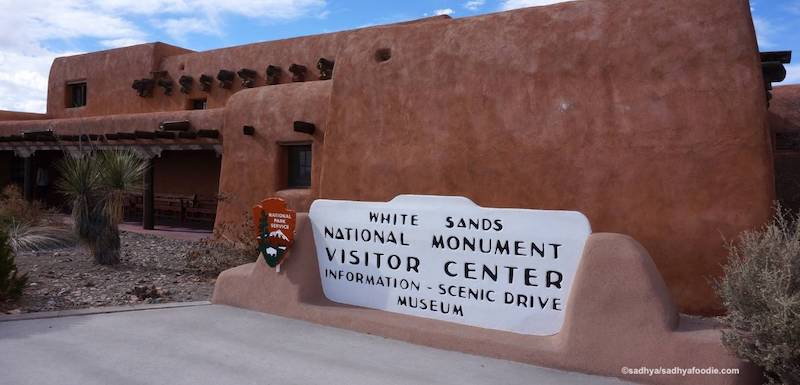
Drive along Dunes Drive
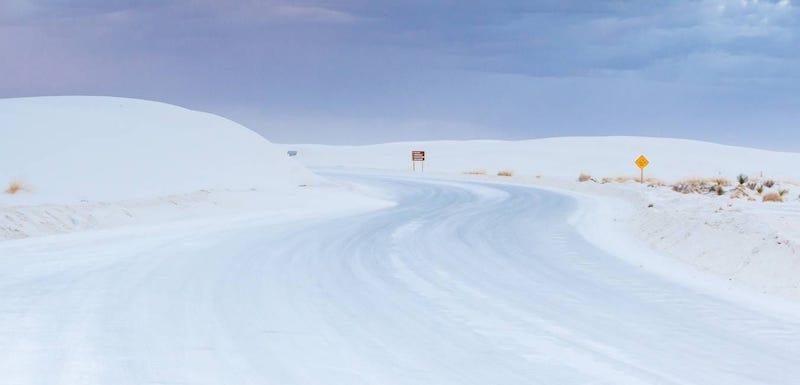
There is only one main road (Dunes Drive) in White Sands National Park, this eight-mile (13-kilometer) scenic drive Dunes Drive leads from the visitor center into the heart of the gypsum dune field. The round-trip distance of 16 miles (26 kilometers) takes about 45 minutes. You should, however, make time for walks in the white sand, photography, and learning about natural and cultural history.
The first four miles of Dunes Drive are paved, while the remaining four miles are hard-packed gypsum roads. The road is appropriate for automobiles, motorcycles, recreational vehicles, and buses. There are wayside exhibits, hiking trails, picnic areas, vault toilets, and parking areas along the road.
Sled Down The Sand Dune
Gypsum dunes are white and powdery, and they behave like snow as well. Sledding is permitted on Dunes Drive’s loop section, which is away from the road and has little to no vegetation. At White Sands National Park, sledding down the slip face of dunes is a popular and thrilling activity.
You can bring or rent a sled down the sand dune and it sounds like a lot of fun, especially if you’re going with children. Most sledders use plastic snow saucers that have been waxed; these can be bought at the park gift shop.
Play On The Sand
If you want to play in the sand, continue down Dunes Drive into the heart of the dunes, where there are dunes for sledding and shaded picnic tables.
The park is famous for its dazzling white dunes, which are so soft and pure white that they are frequently mistaken for snow. You can climb the dunes pretty much anywhere at White Sands, there’s no designated ‘climbing area’ as such. We recommend going to the back of the park, along the 3-mile gypsum loop, simply find a spot that appeals to you, park your car, and begin walking.
Photography
White Sands National Park is a place where anyone can take beautiful photos, regardless of whether they are using a high-end DSLR camera or their smartphone. Visitors are literally surrounded by compelling subjects to photograph in an expansive dune field, which features a wide variety of shapes and angles, timeless vistas, and piercing contrasts.
Hiking On The Trails
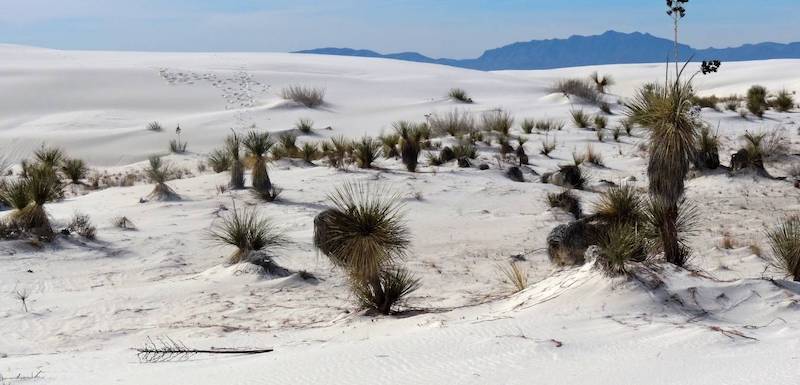
You are enticed to go for a hike by a vast sea of gypsum dunes that are snow-white. The best way to experience White Sands National Park’s distinctive landscape is to set out on one of the five designated trails. Discover the dunes and take in the solitude and peace of the dune field with breathtaking views of the mountains nearby. To ensure a fun and safe hike, make a plan in advance.
The park also has five trails, one of which is a boardwalk that is wheelchair and stroller accessible.
Interdune Boardwalk (Difficulty: Easy)
Distance: 0.4 mile (650m), round-trip | Difficulty: Easy | Time: 20 Minutes
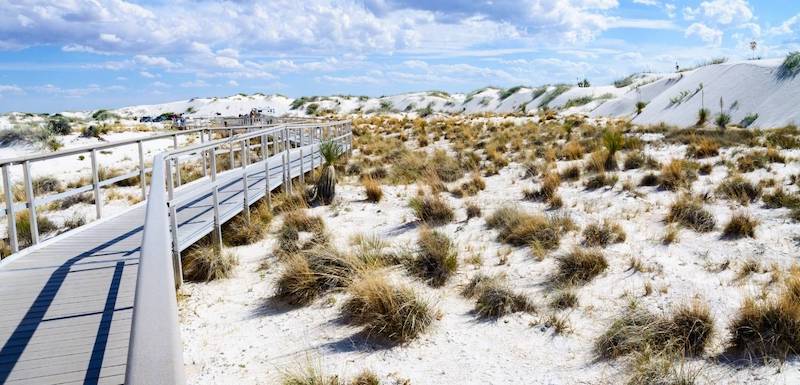
This 0.4-mile boardwalk winds through the dunes and is ideal for anyone who has difficulty walking on sand. Wheelchairs, strollers, and other wheeled devices have full access to the boardwalk. Learn more about Interdune Boardwalk
The Interdune Boardwalk is an elevated boardwalk that takes you through the delicate interdune area to a scenic view of the dune field and the Sacramento mountains. Along the boardwalk, there are ten outdoor exhibits to enjoy.
Playa Trail (Difficulty: Easy)
Distance: 0.5 miles (800m), round-trip | Difficulty: Easy | Time: 15 to 30 minutes
This short, family-friendly, easy trail is a 0.5-mile flat trail with outdoor displays that end with a little playa! Learn more about Playa Trail. It is one of the easiest trails to hike at the park.
Dune Life Nature Walk (Difficulty: Moderate)
Distance: One mile (1.6 km) loop), round-trip | Difficulty: Moderate | Time: 1 hour
Compared to other areas of the dune field, this trail is more densely vegetated and runs along the edge of the dunes. In order to complete this moderate hike, you will need to hike up two steep dunes and walk on soft sand. The trail ascends a steep slope onto the sand dunes after starting out level on the desert plain for the first 300 yards.
This is a moderate hike and it allows you to see the merge of both ecosystems desert scrub and white sands. It takes about 1 hour to complete. Learn more about Dune Life Nature Trail.
Backcountry Camping Trail
Backcountry camping is possible at White Sands! The trail is 2 miles round trip and is ideal for a quick day hike while visiting the park.
Alkali Flat Trail (Difficulty: Strenuous)
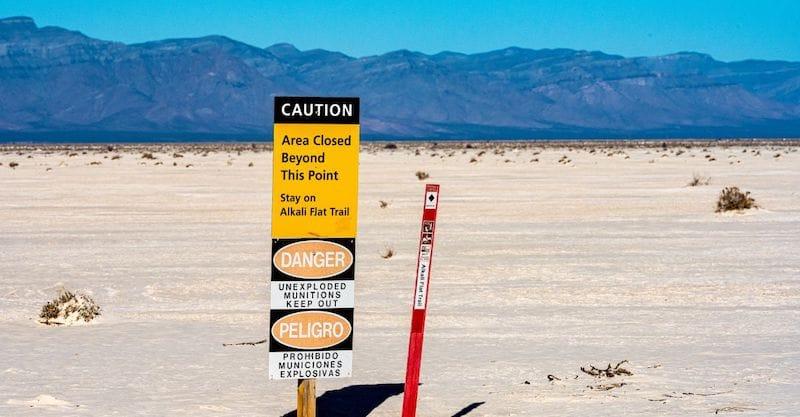
This is a strenuous hike that covers a total distance of five miles (8 kilometers) round-trip. This trail is only accessible by foot. The trail is not open to bicycles, horses, or motorized vehicles.
Although the trail is called “Alkali Flat,” please keep in mind that it is not flat! The hike takes about 3 hours to complete.
This trail is the most difficult in the park, it takes you to the edge of what was Lake Otero in the past. Learn more about Alkali Flat Trails. The park’s site does have caution suggesting you should only go on this trail if you’re prepared.
Always follow the safety precautions when hiking.
Ranger Programs
Throughout the year, park rangers lead a variety of programs and excursions that are available to help you explore the park in a variety of ways. Join a ranger as they unravel the secrets of a geologic marvel sculpted by wind and water that protects the past and is home to various plants and animals. You can find more about the hike with a ranger program here
Sunset Stroll
This is the most popular hike led by a ranger. Learn about the park’s geology as well as the plants and animals that live there on this short walk. The stroll will conclude at sunset. It lasts 45 minutes to an hour, is free, and requires no reservations. Get tour schedules here
Enjoy a Family Picnic
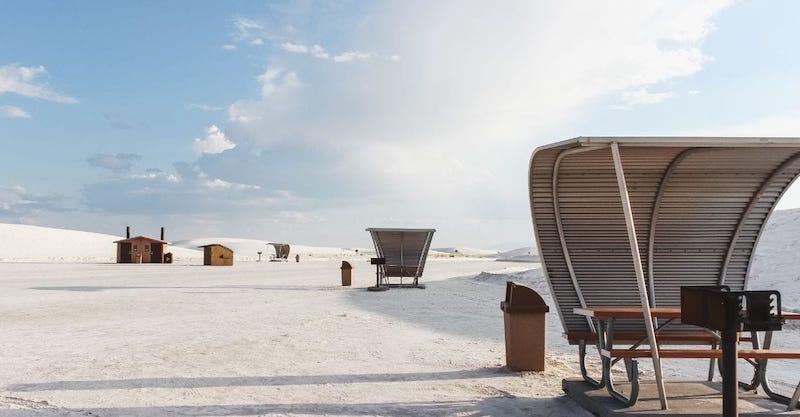
Picnicking in the White Sands National Park has been one of the area’s most popular attractions. Choose your own picnicking methods, such as using a blanket and an umbrella for shade, a tailgate, or one of the many covered picnic tables and grills that are available all over the park.
There are 60-plus picnic tables between the three designated picnic areas in the middle of the dunes near the end of Dunes Drive and the two picnic tables next to the visitor center at the park’s entrance. The only way to reserve one of these picnic areas is on a first-come, first-served basis. Organized groups may reserve one picnic area in advance, and check with the visitor center.
Bicycling
Cycling through the park provides unobstructed views of an ever-changing dune field and allows you to fully immerse yourself in the sights and sounds of this unique landscape. Bicycles are only permitted on Dunes Drive and are not allowed on hiking trails or off-trail in backcountry areas, so visitors planning to explore by bicycle should be aware of this restriction.
While bicycles are permitted on the road, they are not without danger. The scenic road is narrow and is only paved for the first five miles. Follow all traffic laws and wear bright colors, protective clothing, and a helmet.
Watch the Sunset
We stayed for the sunset on the white sands and it was so beautiful.
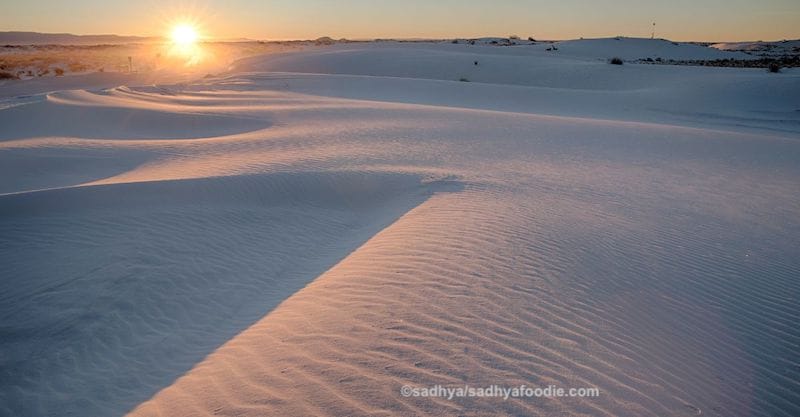
Things to know before visiting white sands, New Mexico
White Sands missile testing range is right next to Whites Sands National park, and when they conduct missile testing, the National Monument is occasionally closed for obvious safety reasons.
Check Park’s Website Before you go
You can check the national park’s website for road closure information before making travel arrangements; you don’t want to make the long drive for nothing!
How much time do you need in white sands national park?
This park is small and only has a short list of must-see attractions, you won’t need to spend much time here to explore the park. In a half-day, you can hike one to two trails and do some sledding.
Plan to spend a full day in White Sands National Park for the best experience. Early in the morning, before the crowds arrive and the temperature rises, hike one of the longer Trails. Have a picnic lunch and go sledding on the dunes around noon. Take the Sunset Stroll, which is a ranger-led tour, at night.
Be Prepared for the Heat
Keep in mind that White Sands is a desert and that it can get hot there. If at all possible, avoid going during the summer when the temperature can easily reach 38°C (100°F) during the day. Even in the summer make sure to wear a hat, long sleeves, and pants to protect your skin from the sun.
The best time to visit White Sands National Park is from October to April when daytime temperatures range from 15 to 25 °C (60 to 80 °F) and nighttime lows are between 0 and °C (20 to 40 °F).
It is not advised to begin a longer hike if the temperature is at or above 85°F (30°C).
Take Your Sunglasses & Sunscreen
The white sand reflects the sun and it will be so bright that you will need your sunglasses to protect your eyes. Even if the sun isn’t shining brightly, don’t forget to wear sunglasses and sunscreen. You’ll be grateful later!
Take enough water
White Sands is a harsh, unforgiving landscape. There is no shade, and even short hikes will leave you dehydrated. The dune field has no available water.
Bring plenty of water, especially if you’re hiking, and make frequent stops to sip. Take at least one gallon (4L) of water per person per day and high-energy snacks like fruit and nuts.
Before you start your hike, drink some water. You can fill up your water bottles at the visitor center. You will require more water than you think. On each trial, bring at least two 32-ounce (1 L) bottles of water per person (double for longer hikes). Return to your car when your water is half-empty.
Beware of the Danger of Getting Lost
The five hiking trails that surround White Sands National Park are color-coded and each has a symbol. If you can’t see the next trail marker because of blowing sand or because it’s been knocked down, it’s time to turn around and go back to your car.
Strong winds, particularly in the spring, can reduce visibility to a few feet and make it easy to become disoriented. You don’t have to hike the entire trail to take in the breathtaking scenery. Make sure you’re out of the trails by sunset.
On longer trails, it is easy to get lost since there is no clear path to follow. In the vast endless white Dune environment, it is so easy to get disoriented so take extra precautions if you are planning to take longer trails for hiking.
Hiking Safety
It is recommended that you do not hike alone. Tell someone you’re not with where you’re going and when you expect to return. Bring a fully charged phone and set it to airplane mode while hiking to save battery life.
Where To Stay
You can stay in Las Cruces or Alamogordo. Las Cruces is a larger town with more dining options and accommodations. This is more convenient for people coming from Arizona or Texas.
Alamogordo
Alamogordo is closer to the national park but it is a smaller town. This is more convenient for people coming from Northern New Mexico (Santa Fe, Albuquerque). It takes about 20 minutes to drive from the park entrance to Alamogordo.
Alamogordo has a few chain restaurants like Buffalo Wild Wings, Chili’s, Applebee’s, IHOP, and Starbucks. Another place to consider is D. H. Lescombe’s Winery and Bistro.
Las Cruces
Las Cruces is about 45 minutes to an hour away from White Sands.
Picacho Of Coffee Roasters
It’s a local coffee roaster with an excellent cool space inside. They have a coffee bar and they roast their own coffee in-house. You can watch how they process coffee beans and make bakery goods. It will take a few minutes to get done since they grind the coffee beans when you order and then percolate the coffee.
Habanero’s Fresh Mex
Habaneros is a wonderful option if you prefer a more casual atmosphere. You can order food at the counter, and it will be brought to you. When you’re in a hurry, these places are quick and reasonably priced.
Visit the National Park Service website before your trip to get the most recent information on trail closures and road conditions.
Where To Go Next?
ALBUQUERQUE: Top 10 places to Visit in Albuquerque New Mexico




